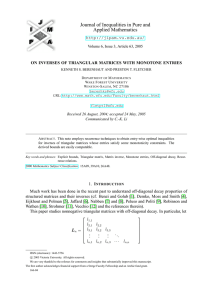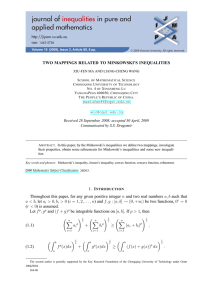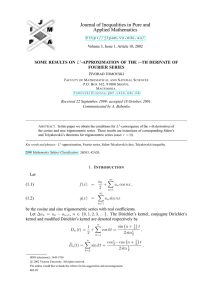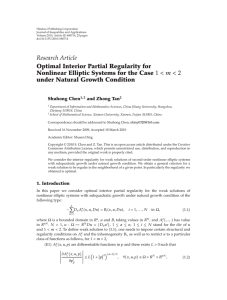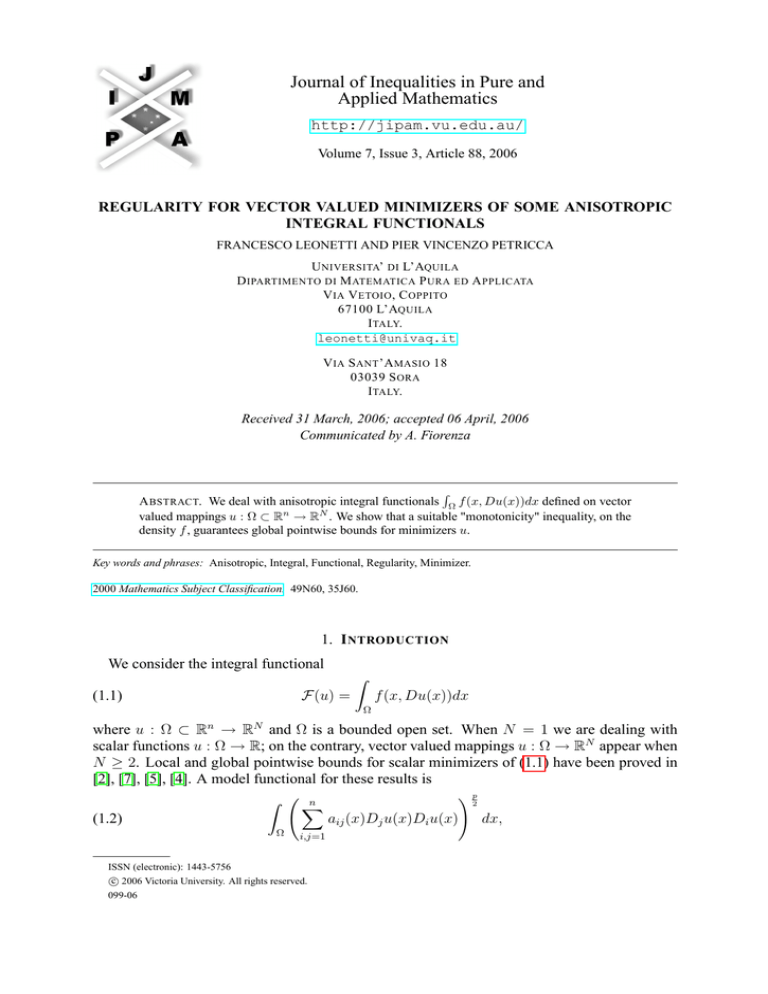
Journal of Inequalities in Pure and
Applied Mathematics
http://jipam.vu.edu.au/
Volume 7, Issue 3, Article 88, 2006
REGULARITY FOR VECTOR VALUED MINIMIZERS OF SOME ANISOTROPIC
INTEGRAL FUNCTIONALS
FRANCESCO LEONETTI AND PIER VINCENZO PETRICCA
U NIVERSITA’ DI L’AQUILA
D IPARTIMENTO DI M ATEMATICA P URA ED A PPLICATA
V IA V ETOIO , C OPPITO
67100 L’AQUILA
I TALY.
leonetti@univaq.it
V IA S ANT ’A MASIO 18
03039 S ORA
I TALY.
Received 31 March, 2006; accepted 06 April, 2006
Communicated by A. Fiorenza
R
A BSTRACT. We deal with anisotropic integral functionals Ω f (x, Du(x))dx defined on vector
valued mappings u : Ω ⊂ Rn → RN . We show that a suitable "monotonicity" inequality, on the
density f , guarantees global pointwise bounds for minimizers u.
Key words and phrases: Anisotropic, Integral, Functional, Regularity, Minimizer.
2000 Mathematics Subject Classification. 49N60, 35J60.
1. I NTRODUCTION
We consider the integral functional
Z
F(u) =
(1.1)
f (x, Du(x))dx
Ω
where u : Ω ⊂ Rn → RN and Ω is a bounded open set. When N = 1 we are dealing with
scalar functions u : Ω → R; on the contrary, vector valued mappings u : Ω → RN appear when
N ≥ 2. Local and global pointwise bounds for scalar minimizers of (1.1) have been proved in
[2], [7], [5], [4]. A model functional for these results is
! p2
Z
n
X
(1.2)
aij (x)Dj u(x)Di u(x)
dx,
Ω
i,j=1
ISSN (electronic): 1443-5756
c 2006 Victoria University. All rights reserved.
099-06
2
F RANCESCO L EONETTI AND P IER V INCENZO P ETRICCA
where coefficients aij are measurable, bounded and elliptic. Previous results for scalar minimizers are no longer true in the vector valued case N ≥ 2 as De Giorgi’s counterexample shows,
[3]. Some years later, attention has been paid to anisotropic functionals whose model is
Z
(1.3)
(|D1 u(x)|p1 + |D2 u(x)|p2 + · · · + |Dn u(x)|pn ) dx,
Ω
where each component Di u of the gradient Du = (D1 u, D2 u, . . . , Dn u) may have a (possibly)
different exponent pi : this seems useful when dealing with some reinforced materials, [9]; see
also [6, Example 1.7.1, page 169]. In the framework of anisotropic functionals, global pointwise bounds have been proved for scalar minimizers in [1] and [8]. If no additional conditions
are assumed, these bounds are false in the vectorial case, as the above mentioned counterexample shows, [3]. The aim of this paper is to present a “monotonicity” assumption ensuring
boundedness of vector valued minimizers. In order to do that, we recall that u : Ω ⊂ Rn → RN
thus Du(x) is a matrix with N rows and n columns; the density f (x, A) in (1.1) is assumed to
be measurable with respect to x, continuous with respect to A and f : Ω × RN ×n → [0, +∞).
Every matrix A = {Aαi } ∈ RN ×n will have N rows A1 , . . . , AN and n columns A1 , . . . , An . In
this paper we will show that the following “monotonicity” inequality guarantees global pointwise bounds for vector valued minimizers of (1.1):
n pi
X
(1.4)
f (x, Ã) + µ
Ã
−
A
i
i ≤ f (x, A) + M (x)
i=1
for every pair of matrices Ã, A ∈ RN ×n such that there exists a row β with Ãβ = 0 and for
every remaining row α 6= β we have Ãα = Aα . In (1.4) µ, p1 , . . . , pn are positive constants with
pi > 1 and M : Ω → [0, +∞) with MP∈ Lr (Ω), r ≥ 1. If we keep in mind that A = Du(x),
then the left hand side of (1.4) shows ni=1 |Ãi − Di u(x)|pi , thus each component Di u of the
gradient Du may have a possibly different exponent pi , so we are in the anisotropic framework:
−1
P
n
1
1
N
1,1
N
pi
u ∈ W (Ω, R ) with Di u ∈ L (Ω, R ). In this case the harmonic mean p = n i=1 pi
comes into play. In Section 2 we will prove the following
Theorem 1.1. We consider the functional (1.1) under the “monotonicity” inequality (1.4) with
p∗
1
(1.5)
1−
>1
p
r
where p∗ is the Sobolev exponent of p < n. We consider u = (u1 , . . . , uN ) ∈ W 1,1 (Ω, RN ),
with Di u ∈ Lpi (Ω, RN ) ∀i ∈ {1, . . . , n}, such that
F(u) < +∞
and
F(u) ≤ F(v)
(1.6)
W01,1 (Ω, RN )
for every v ∈ u +
component uβ , we have
(1.7)
with Di v ∈ Lpi (Ω, RN ) ∀i ∈ {1, . . . , n}. Then, for every
inf uβ − c∗ ≤ uβ (x) ≤ sup uβ + c∗
∂Ω
∂Ω
for almost every x ∈ Ω, where
1
i
h
i−1
∗
∗h
∗
kM kLr (Ω) p
1− r1 ) pp −1 p1∗ (1− r1 ) pp (1− r1 ) pp −1
(
c∗ = c
|Ω|
2
,
µ
c = c(n, p1 , . . . , pn ) > 0 and |Ω| is the Lebesgue measure of Ω.
J. Inequal. Pure and Appl. Math., 7(3) Art. 88, 2006
http://jipam.vu.edu.au/
M INIMIZERS OF A NISOTROPIC F UNCTIONALS
3
A model density f for the “monotonicity” inequality (1.4) is given in the following.
Lemma 1.2. For every i = 1, . . . , n, let us consider pi ∈ [2, +∞) and ai ∈ (0, +∞); we take
m : Ω → [0, +∞) and h : R → R with −∞ < inf R h. Let us consider f : Ω × Rn×n → R
defined as follows:
n
X
(1.8)
f (x, A) =
ai |Ai |pi + m(x)h(det A).
i=1
Then the “monotonicity” inequality (1.4) holds true with µ = minj aj and M (x) = m(x)[h(0)−
inf R h]. Moreover, if h ≥ 0, then f ≥ 0 too.
2. P ROOFS
In order to prove Theorem 1.1, we need the following
Lemma 2.1. Let us consider the functional (1.1) under the “monotonicity” assumption (1.4).
Then, for every v = (v 1 , . . . , v N ) ∈ W 1,1 (Ω, RN ) with Di v ∈ Lpi (Ω, RN ) ∀i ∈ {1, . . . , n}, for
any β ∈ {1, . . . , N }, for all t ∈ R, it results that
Z
n Z
X
pi
M (x)dx
|Di (Iβ,t (v(x))) − Di v(x)| dx ≤ F(v) +
(2.1)
F(Iβ,t (v)) + µ
i=1
{v β >t}
Ω
where Iβ,t : RN → RN is defined as follows:
∀y = (y 1 , . . . , y N ) ∈ RN ,
1
N
Iβ,t (y) = (Iβ,t
(y), . . . , Iβ,t
(y))
with
(
α
Iβ,t
(y)
(2.2)
=
yα
if α 6= β
y β ∧ t = min {y β , t} if α = β.
Proof. For every v ∈ W 1,1 (Ω, RN ), with Di v ∈ Lpi (Ω, RN ) ∀i ∈ {1, . . . , n}, it results that
Iβ,t (v) ∈ W 1,1 (Ω, RN ); moreover
(
Di v α
if α 6= β
α
(2.3)
Di (Iβ,t (v)) =
1{vβ ≤t} Di v β if α = β,
where 1B is the characteristic function of the set B, that is, 1B (x) = 1 if x ∈ B and 1B (x) = 0 if
x∈
/ B. Therefore Di (Iβ,t (v)) ∈ Lpi (Ω, RN ) ∀i ∈ {1, . . . , n}. On {x ∈ Ω : v β (x) > t} we have
β
α
D(Iβ,t
(v)) = 0 and, for α 6= β, D(Iβ,t
(v)) = Dv α ; so we can apply (1.4) with à = D(Iβ,t (v))
and A = Dv; we obtain
n
X
(2.4)
f (x, D(Iβ,t (v(x)))) + µ
|Di (Iβ,t (v(x))) − Di v(x)|pi ≤ f (x, Dv(x)) + M (x)
i=1
β
β
for x ∈ {v > t}. On {x ∈ Ω : v (x) ≤ t} D(Iβ,t (v)) = Dv, thus
(2.5)
f (x, D(Iβ,t (v(x)))) + µ
n
X
|Di (Iβ,t (v(x))) − Di v(x)|pi = f (x, Dv(x))
i=1
β
for x ∈ {v ≤ t}. From (2.4) and (2.5) we have
f (x, D(Iβ,t (v(x)))) + µ
n
X
|Di (Iβ,t (v(x))) − Di v(x)|pi ≤ f (x, Dv(x)) + M (x)1{vβ >t} (x)
i=1
J. Inequal. Pure and Appl. Math., 7(3) Art. 88, 2006
http://jipam.vu.edu.au/
4
F RANCESCO L EONETTI AND P IER V INCENZO P ETRICCA
for x ∈ Ω. If x → f (x, Dv(x)) ∈ L1 (Ω), then x → f (x, D(Iβ,t (v(x)))) ∈ L1 (Ω) too and,
integrating the last inequality with respect to x, we get (2.1). When x → f (x, Dv(x)) ∈
/ L1 (Ω),
we have F(v) = +∞ and (2.1) holds true. This ends the proof of Lemma 2.1.
Now we are ready to prove Theorem 1.1.
Proof. Let us fix β ∈ {1, . . . , N }. If sup∂Ω uβ = +∞ then the right hand side of (1.7) is
satisfied. Thus we assume sup∂Ω uβ < t0 ≤ t < +∞ and we note that under this assumption
Iβ,t (u) ∈ u + W01,1 (Ω, RN ) and Di (Iβ,t (u)) ∈ Lpi (Ω, RN ) ∀i ∈ {1, . . . , n} since
uβ ∧ t = min {uβ , t} = uβ − [max {uβ − t, 0}] = uβ − [(uβ − t) ∨ 0],
where (uβ − t) ∨ 0 ∈ W01,1 (Ω) and Di ((uβ − t) ∨ 0) = Di uβ 1{uβ >t} ∈ Lpi (Ω) ∀i ∈ {1, . . . , n}.
From (1.6) and (2.1) it results that
F(u) ≤ F(Iβ,t (u))
Z
n Z
X
pi
|Di (Iβ,t (u(x))) − Di u(x)| dx +
≤ F(u) − µ
i=1
M (x)dx,
{uβ >t}
Ω
that is
µ
(2.6)
n Z
X
i=1
pi
Z
|Di (Iβ,t (u(x))) − Di u(x)| dx ≤
M (x)dx.
{uβ >t}
Ω
If we define φ = (uβ − t) ∨ 0, then we can write (2.6) as follows:
Z
n Z
X
pi
|Di φ(x)| dx ≤
M (x)dx.
(2.7)
µ
i=1
{uβ >t}
Ω
R
If r < +∞, we apply Hölder’s inequality to {uβ >t} M (x)dx and we obtain
Z
1− r1
β
M (x)dx ≤ kM kLr (Ω) |{u > t}|
.
{uβ >t}
If r = +∞, then
Z
β
β
M (x)dx ≤ kM kL∞ (Ω) |{u > t}| = kM kLr (Ω) |{u > t}|
1− r1
.
{uβ >t}
In both cases, from (2.7) it results that
n Z
X
kM kLr (Ω) β
|Di φ(x)|pi dx ≤
|{u > t}|
µ
Ω
i=1
1− r1
in particular, ∀i ∈ {1, . . . , n}
Z
kM kLr (Ω) β
1− r1
pi
|Di φ(x)| dx ≤
|{u > t}|
µ
Ω
from which
Z
p1
p1i
i
kM kLr (Ω) β
1− r1
pi
≤
|{u > t}|
|Di φ(x)| dx
µ
Ω
and finally
" n Z
p1 # n1
p1
Y
i
kM kLr (Ω) β
1− r1
pi
≤
|{u > t}|
(2.8)
|Di φ(x)| dx
.
µ
Ω
i=1
J. Inequal. Pure and Appl. Math., 7(3) Art. 88, 2006
http://jipam.vu.edu.au/
M INIMIZERS OF A NISOTROPIC F UNCTIONALS
5
We apply the anisotropic imbedding theorem [10] and we use (2.8):
Z
p1∗
β
p∗
(2.9)
0≤
u (x) − t dx
{uβ >t}
= kφkLp∗ (Ω)
" n Z
p1 # n1
Y
i
≤c
|Di φ(x)|pi dx
Ω
i=1
kM kLr (Ω) β
≤c
|{u > t}|
µ
1− r1
p1
,
where c = c(n, p1 , . . . , pn ) > 0. If kM kLr (Ω) = 0, then from (2.9) it results that uβ ≤ t almost
everywhere in Ω and we are done. If kM kLr (Ω) > 0, then for T > t we have
Z
∗
p∗
β
(2.10)
(T − t) |{u > T }| =
(T − t)p dx
{uβ >T }
Z
β
p∗
≤
u (x) − t dx
{uβ >T }
Z
β
p∗
≤
u (x) − t dx
{uβ >t}
and from (2.9) and (2.10) we get
β
|{u > T }| ≤ c
(2.11)
p∗
kM kLr (Ω)
µ
pp∗
1
β
> t}|
∗ |{u
p
(T − t)
1− r1
p∗
p
for every T, t with T > t ≥ t0 . We set χ(t) = |{uβ > t}| and we use [7, Lemma 4.1, p. 93],
that we provide below for the convenience of the reader.
Lemma 2.2. Let χ : [t0 , +∞) → [0, +∞) be decreasing. We assume that there exist k, a ∈
(0, +∞) and b ∈ (1, +∞) such that
T > t ≥ t0 =⇒ χ(T ) ≤
(2.12)
k
(χ(t))b .
(T − t)a
Then it results that
"
χ(t0 + d) = 0
(2.13)
d = k(χ(t0 ))b−1 2
where
ab
(b−1)
# a1
.
We use the previous Lemma 2.2 and we have
|{uβ > t0 + d}| = 0
(2.14)
that is
uβ ≤ t0 + d
(2.15)
almost everywhere in Ω, where
d=c
kM kLr (Ω)
µ
p1
h
β
{u > t0 }
J. Inequal. Pure and Appl. Math., 7(3) Art. 88, 2006
1− r1
p∗
−1
p
i
1
p∗
2
1− r1
h
p∗
p
1− r1
p∗
−1
p
i−1
.
http://jipam.vu.edu.au/
6
F RANCESCO L EONETTI AND P IER V INCENZO P ETRICCA
In order to get the right hand side of (1.7), we control |{uβ > t0 }| by means of |Ω| and we take
a sequence {(t0 )m }m with (t0 )m → sup∂Ω uβ . Let us show how we obtain the left hand side of
(1.7): we apply the right hand side of (1.7) to −u. This ends the proof of Theorem 1.1.
Now we are going to prove Lemma 1.2.
Proof. We assume that Ã, A ∈ Rn×n with Ãβ = 0 and Ãα = Aα for α 6= β. Then
X
X
(2.16)
|Aαi |2 = |Aβi |2 +
|Aαi |2
α
α6=β
=
|Aβi
=
X
− Ãβi |2 +
X
|Ãαi |2
α6=β
|Aαi − Ãαi |2 +
X
α
|Ãαi |2
α
so
|Ai |2 = |Ai − Ãi |2 + |Ãi |2 .
(2.17)
Since pi ≥ 2, the previous equality gives
|Ai |pi ≥ |Ai − Ãi |pi + |Ãi |pi .
(2.18)
Moreover
(2.19)
h(det A) ≥ inf h = h(0) − [h(0) − inf h] = h(det Ã) − [h(0) − inf h].
R
R
R
Now we are able to estimate f (x, A) and f (x, Ã) by means of (2.18) and (2.19) as follows:
n
X
(2.20)
f (x, Ã) + (min aj )
|Ai − Ãi |pi
j
≤
≤
n
X
i=1
n
X
i=1
pi
ai |Ãi | + m(x)h(det Ã) +
n
X
ai |Ai − Ãi |pi
i=1
ai |Ai |pi + m(x)h(det A) + m(x)[h(0) − inf h]
R
i=1
= f (x, A) + m(x)[h(0) − inf h]
R
thus the “monotonicity” inequality (1.4) holds true with µ = minj aj and M (x) = m(x)[h(0) −
inf R h]. This ends the proof of Lemma 1.2.
R EFERENCES
[1] L. BOCCARDO, P. MARCELLINI AND C. SBORDONE, L∞ -regularity for a variational problems
with sharp non standard growth conditions, Boll. Un. Mat. Ital., 4-A (1990), 219–226.
[2] E. DE GIORGI, Sulla differenziabilitá e l’analiticitá delle estremali degli integrali multipli regolari,
Mem. Accad. Sci. Torino Cl. Sci. Fis. Mat. Nat., 3 (1957), 25–43.
[3] E. DE GIORGI, Un esempio di estremali discontinue per un problema variazionale di tipo ellittico,
Boll. Un. Mat. Ital., 4 (1968), 135–137.
[4] M. GIAQUINTA AND E. GIUSTI, On the regularity of the minima of variational integrals, Acta.
Math., 148 (1982), 31–46.
[5] O. LADYZHENSKAYA AND N. URAL’TSEVA, Linear and Quasilinear Elliptic Equations, Academic Press, New York, 1968.
J. Inequal. Pure and Appl. Math., 7(3) Art. 88, 2006
http://jipam.vu.edu.au/
M INIMIZERS OF A NISOTROPIC F UNCTIONALS
7
[6] J.L. LIONS, Quelques Methodes de Resolution des Problemes aux Limites Non Lineaires, Dunod,
Gauthier - Villars, Paris, 1969.
[7] G. STAMPACCHIA, Equations Elliptiques du Second Ordre a Coefficientes Discontinus, Semin.
de Math. Superieures, Univ. de Montreal, 16, 1966.
[8] B. STROFFOLINI, Global boundedness of solutions of anisotropic variational problems, Boll. Un.
Mat. Ital., 5-A (1991), 345–352.
[9] Q. TANG, Regularity of minimizers of non-isotropic integrals of the calculus of variations, Ann.
Mat. Pura Appl., 164 (1993), 77–87.
[10] M. TROISI, Teoremi di inclusione per spazi di Sobolev non isotropi, Ricerche Mat., 18 (1969),
3–24.
J. Inequal. Pure and Appl. Math., 7(3) Art. 88, 2006
http://jipam.vu.edu.au/





